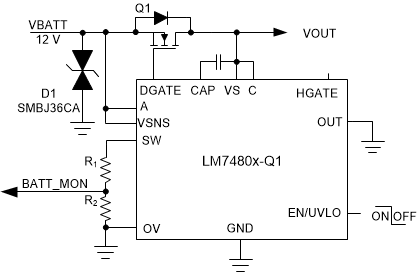SNOSD95C April 2020 – December 2020 LM7480-Q1
PRODUCTION DATA
- 1 Features
- 2 Applications
- 3 Description
- 4 Revision History
- 5 Device Comparison Table
- 6 Pin Configuration and Functions
- 7 Specifications
- 8 Parameter Measurement Information
- 9 Detailed Description
-
10Applications and Implementation
- 10.1 Application Information
- 10.2 Typical 12-V Reverse Battery Protection Application
- 10.3 200-V Unsuppressed Load Dump Protection Application
- 10.4 Do's and Don'ts
- 11Power Supply Recommendations
- 12Layout
- 13Device and Documentation Support
- 14Mechanical, Packaging, and Orderable Information
9.3.2.1 Reverse Battery Protection (A, C, DGATE)
A, C, DGATE comprises of Ideal Diode stage. Connect the Source of the external MOSFET to A, Drain to C and Gate to DGATE. The LM7480x-Q1 has integrated reverse input protection down to –65 V.
Before the DGATE driver is enabled, following conditions must be achieved:
- The EN/UVLO pin voltage must be greater than the specified input high voltage.
- The CAP to VS voltage must be greater than the undervoltage lockout voltage.
- Voltage at A pin must be greater than VA POR Rising threshold.
- Voltage at Vs pin must be greater than Vs POR Rising thershold.
In LM74800-Q1 the voltage drop across the MOSFET is continuously monitored between the A and C pins, and the DGATE to A voltage is adjusted as needed to regulate the forward voltage drop at 10.5 mV (typ). This closed loop regulation scheme enables graceful turn off of the MOSFET during a reverse current event and ensures zero DC reverse current flow. This scheme ensures robust performance during slow input voltage ramp down tests. Along with the linear regulation amplifier scheme, the LM74800-Q1 also integrates a fast reverse voltage comparator. When the voltage drop across A and C reaches V(AC_REV) threshold then the DGATE goes low within 0.5-µs (typ). This fast reverse voltage comparator scheme ensures robust performance during fast input voltage ramp down tests such as input micro-shorts. The external MOSFET is turned ON back when the voltage across A and C hits V(AC_FWD) threshold within 2.8 µs (typ).
In LM74801-Q1, reverse current blocking is by fast reverse voltage comparator only. When the voltage drop across A and C reaches V(AC_REV) threshold then the DGATE goes low within 0.5 µs (typ). This fast reverse voltage comparator scheme ensures robust performance during fast input voltage ramp down tests such as input micro-shorts. The external MOSFET is turned ON back when the voltage across A and C hits V(AC_FWD) threshold within 2.8 µs (typ).
For Ideal Diode only designs, connect LM7480x-Q1 as shown in Figure 9-2 Figure 9-2 Configuring LM7480x-Q1 for Ideal Diode Only
Figure 9-2 Configuring LM7480x-Q1 for Ideal Diode Only|
Feature | LM74800-Q1 |
LM74801-Q1 |
|---|---|---|
| DGATE drive | DGATE gets pulled to A. MOSFET Q1 turned OFF. | DGATE to A fully enhanced. MOSFET Q1 turned ON. |
| Reverse Polarity Protection | Yes. | Yes. |
| Reverse Current Blocking | Yes. | No. Allows bi-directional current flow. |